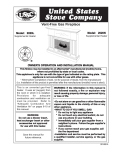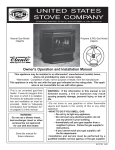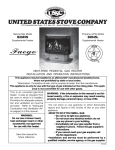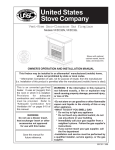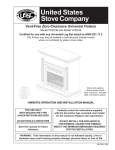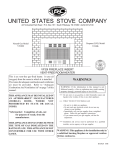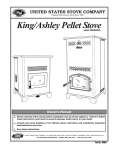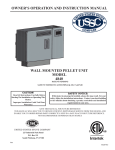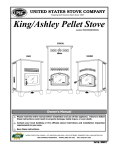Download United States Stove 2020L Installation manual
Transcript
United States Stove Company Vent-Free Gas Fireplace Model: 2020L Model: 2020N OWNER'S OPERATION AND INSTALLATION MANUAL This firebox may be installed in an aftermarket* manufactured (mobile) home, where not prohibited by state or local codes. * Aftermarket: Completion of sale, not for purpose of resale, from the manufacturer (i.e. Installation of this product is permitted after the manufactured (mobile) home is sited). This is an unvented gas-fired heater. It uses air (oxygen) from the room in which it is installed. Provisions for adequate combustion and ventilation air must be provided. Refer to "Adequate Combustion And Ventilation Air" on pages 6-10 of this manual. WARNING: Do not use a blower insert, heat exchanger insert or other accessories not approved for use with this heater. Save this manual for future reference. WARNING: If the information in this manual is not followed exactly, a fire or explosion may result causing property damage, personal injury, or loss of life. ~Do not store or use gasoline or other flammable vapors and liquids in the vicinity of this or any other appliance. ~WHAT TO DO IF YOU SMELL GAS * Do not try to light any appliance * Do not touch any electrical switch; do not use any phone in your building * Immediately call your gas supplier from a neighbor's phone. Follow the gas supplier's instructions * If you cannot reach your gas supplier, call the fire department ~Installation and service must be performed by a qualified installer, service agency, or the gas supplier. 851466A 01/01 TABLE OF CONTENTS SECTION PAGE LOCAL CODES.......................................................................................................2 WARNINGS/SAFETY INFORMATION.................................................................2-4 2020 SPECIFICATIONS.....................................................................................4-5 PRODUCT FEATURES...........................................................................................6 LOCATING THE FIREPLACE.....................................................................................6 AIR FOR COMBUSTION AND VENTILATION..................................................6-10 INSTALLATION................................................................................................10-11 SCREEN REMOVAL.............................................................................................11 GAS CONNECTION........................................................................................12-13 GAS PRESSURE CHECK.....................................................................................13 LOG ASSEMBLY...................................................................................................14 OPERATING INSTRUCTIONS........................................................................15-17 CLEANING/SERVICING..................................................................................17-18 FLAME APPEARANCE.........................................................................................18 PARTS DIAGRAM & LIST.................................................................................19-20 BLOWER KIT WIRING DIAGRAM.......................................................................21 OPTIONAL ACCESSORIES.................................................................................22 WIRING GUIDE FOR 2020.............................................................................23-24 NOTES............................................................................................................25-27 HOW TO ORDER REPAIR PARTS........................................................................28 LOCAL CODES Install and use fireplace with care. Follow all local codes. In the absence of local codes, use the latest edition of The National Fuel Gas Code ANSI Z223.1, also known as NFPA 54*. Firebox must be electrically grounded in accordance with the National Electric Code, ANSI/ NFPA 70 (latest edition). *Available from: American National Standards Institute, Inc. 1430 Broadway New York, NY 10018 National Fire Protection Association, Inc. Batterymarch Park Quincy, MA 02269 WARNINGS/SAFETY INFORMATION IMPORTANT: Read this owner's manual carefully and completely before trying to assemble, operate, or service this fireplace. Improper use of this fireplace can cause serious injury or death from burns, fire, explosion, electrical shock, and carbon poisoning. 2 WARNINGS/SAFETY INFORMATION CONTINUED WARNING: Any change to this heater or its controls can be dangerous. 1. This heater shall not be installed in a bedroom or bathroom. 2. Never install the fireplace * in a recreational vehicle * where curtains, furniture, clothing, or other flammable objects are less than 36 inches from the front, top, or side of the fireplace * in high traffic areas * in windy or drafty areas 3. Do not add extra logs or ornaments such as pine cones, vermiculite, or rock wool. Using these added items can cause sooting. 4. You must operate this fireplace with the fireplace screen in place. Make sure these parts are in place before running. 5. Do not allow fans to blow directly into the firebox. Avoid any drafts that alter burner flame patterns. Ceiling fans can create drafts that alter burner flame patterns. Altered burner patterns can cause sooting. 6. To prevent malfunction and/or sooting, an unvented gas heater should be cleaned at least annually by a professional service person. More frequent cleaning may be required due to excessive lint from carpeting, etc. It is imperative that control compartments, burners and circulating air passageways be kept clean. 7. Correct placement of the ceramic fiber logs is necessary to avoid problems with sooting. Sooting can settle on surfaces outside the heater and cause discoloration. See the appropriate section of this manual for instructions. 8. This Vent-free gas log heater requires fresh air ventilation to run properly. See Air for Combustion and Ventilation instructions in this owner's manual. 9. Do not run fireplace * where flammable liquids or vapors are used or stored * under dusty conditions 10. Do not use this fireplace to cook food or burn paper or other objects. 11. Never place any objects in the firebox or on logs. 12. Fireplace front and screen becomes very hot when running. Keep children and adults away from hot surfaces to avoid burns or clothing ignition. Firebox will remain hot for a time after shutdown. Allow surfaces to cool before touching. 13. Carefully supervise young children when they are in the room with fireplace. 14. Turn fireplace off and let cool before servicing. Only a qualified service person should service and repair fireplace. 15. Operating vent-free gas log heaters in a fireplace above elevations of 4,500 feet could cause pilot outage. 16. IMPORTANT: The fireplace hood must not be replaced with a hood/canopy which may be provided with the decorative type unvented room heater. 3 WARNINGS/SAFETY INFORMATION CONTINUED 17. CARBON MONOXIDE POISONING: Early signs of carbon monoxide poisoning are similar to the flu with headaches, dizziness and/or nausea. If you have these signs, obtain fresh air immediately. Have the heater serviced as it may not be operating properly. 18. This vent-free gas fireplace is intended to be smokeless. If logs appear to smoke, turn off the heater and call a qualified service person. Initial burn off may cause slight smoke and odor during the first four hours of operation. 19. Input ratings are shown in BTU per hour and are for elevations up to 2,000 feet. For elevations above 2,000 feet, input ratings should be reduced 4 percent for each 1,000 feet above see level. Refer to the National Fuel Gas Code. 20. The appliance and its appliance main gas valve must be disconnected from the gas supply piping system during any pressure testing of that system at test pressures in excess of 1/2 psig (3.5 kPa). 21. The appliance must be isolated from the gas supply piping system be closing its equipment shutoff valve during any pressure testing of the gas supply piping system at test pressures equal to or less than 1/2 psig (3.5 kPa). 22. Do not use this gas fireplace if any part has been under water. Immediately call a qualified service technician to inspect the room heater and to replace any part of the control system and any gas control which has been under water. 2020 SPECIFICATIONS Natural Gas Propane/LPG Manifold Pressure Setting: Gas Inlet Pressure: Maximum Minimum Model Number 2020N 2020L Type Manual Manual 4" w.c. 10-1/2" w.c. 5" w.c. Manifold Pressure Setting: Gas Inlet Pressure: Maximum Minimum Gas Rate Max BTU/Hr Min BTU/Hr 20,000 20,000 14,000 14,000 10" w.c. 13" w.c. 11" w.c. Number of Burners 1 1 Controls - Main control has 3 positions: 1. OFF - All gas to the burner is shut off at the control 2. PILOT - Valve position to light/maintain a standing pilot 3. ON - Opens valve for gas flow to complete system. Piezo Ignitor - allows ignition of the pilot without the use of matches or batteries ON/OFF Switch - Operates gas flow to the burner HIGH / LOW Control - Infinite control : Rotate knob clockwise to LOW, counter clockwise to HIGH. 4 2020 SPECIFICATIONS, CONTINUED... FIREPLACE TOP VIEW FIREPLACE FRONT VIEW FIREPLACE SIDE VIEW 5 PRODUCT FEATURES Operation This Vent-free Gas Fireplace requires no outside venting or chimney making installation easy and inexpensive. When used without the optional blower, the fireplace requires no electricity making it ideal for emergency backup heat. Blower Accessory The 2020 Vent-free Gas Fireplace will accept the Blower Kit accessory. The kit comes with the variable blower. The variable blower allows you to select the fan speed you desire. The blower circulates heated air from the fireplace into the room. Use of the blower is optional. LOCATING FIREPLACE Planning Plan where you will install the fireplace. This will save time and money later when you install the fireplace. Before installation, consider the following: 1. Where the fireplace will be located. Allow for wall and ceiling clearances (see Installation Clearances, pages 10 & 11). 2. Everything needed to complete installation. 3. This model CANNOT be installed in a bedroom or bathroom. 4. Proper air for combustion and ventilation (see below). AIR FOR COMBUSTION AND VENTILATION WARNING This heater shall not be installed in a confined space or unusually tight construction unless provisions are provided for adequate combustion and ventilation air. Read the following instructions to insure proper fresh air for this and other fuelburning appliances in your home. Today's homes are built more energy efficient than ever. New materials, increased insulation, and new construction methods help reduce heat loss in homes. Home owners weather strip and caulk around windows and doors to keep the cold air out and the warm air in. During heating months, home owners want their homes as airtight as possible. While it is good to make your home energy efficient, your home needs to breathe. Fresh air must enter your home. All fuel-burning appliances need fresh air for proper combustion and ventilation. Exhaust fans, fireboxes, clothes dryers, and fuel-burning appliances draw air from the house to operate. You must provide adequate fresh air for these appliances. This will insure proper venting of vented fuel-burning appliances. 6 AIR FOR COMBUSTION AND VENTILATION CONTINUED Providing adequate ventilation The following is excerpts from National Fuel Gas Code. NFPA 54/ANSI Z223.1, Section 5.3, Air for Combustion and Ventilation. All spaces in homes fall into one of the three following ventilation classifications: 1. Unusually Tight Construction; 2. Unconfined Space; 3. Confined Space. The information on pages 6 through 10 will help you classify your space and provide adequate ventilation. Unusually Tight Construction The air that leaks around doors and windows may provide enough fresh air for combustion and ventilation. However, in buildings of unusually tight construction, you must provide additional fresh air. Unusually tight construction is defined as construction where: a. Walls and ceilings exposed to the outside atmosphere have a continuous water vapor retarder with a rating of one perm (6x10 -11kg per pa-sec-m 2 ) or less with openings gasketed or sealed and b. Weather stripping has been added on openable windows and doors and c. Caulking or sealants are applied to areas such as joints around window and door frames, between sole plates and floors, between wall-ceiling joints, between wall panels, at penetrations for plumbing, electrical, and gas lines, and at other openings. If your home meets all of the three criteria above, you must provide additional fresh air. See Ventilation Air From Outdoors, page 10. If your home does not meet all of the three criteria above, proceed to page 8. Confined Space and Unconfined Space The National Fuel Gas Code (ANSI Z223.1, 1992 Section 5.3) defines a confined space as a space whose volume is less than 50 cubic feet per 1,000 BTU per hour (4.8m3 per kw) of the aggregate input rating of all appliances installed in that space and an unconfined space as a space whose volume is not less than 50 cubic feet per 1,000 BTU per hour (4.8m3 per kw) of the aggregate input rating of all appliances installed in that space. Rooms communicating directly with the space in which the appliances are installed*, through openings not furnished with doors, are considered a part of the unconfined space. * Adjoining rooms are communicating only if there are doorless passageways or ventilation grills between them. 7 AIR FOR COMBUSTION AND VENTILATION CONTINUED Determining if You Have a Confined or Unconfined Space Use this worksheet to determine if you have a confined or unconfined space. Space: Includes the room in which you will install the firebox plus any adjoining rooms with doorless passageways or ventilation grills between the rooms. 1. 2. 3. Determine the volume of the space (length x width x height). Length x Width x Height = _______________ cu. Ft. (volume of space) Example: Space size 22 ft. (length) x 18 ft. (width) x 8 ft. (ceiling height) = 3168 cu. Ft. (volume of space) If additional ventilation to adjoining room is supplied with grills or openings, add the volume of these rooms to the total volume of the space. Divide the space volume by 50 cubic feet to determine the maximum BTU/Hr the space can support. _________ (volume of space) 50 cu. Ft. = (Maximum BTU/Hr the space can support) Example: 3168 cu. Ft. (volume of space) 50 cu. Ft. = 63.3 or 63,300 (maximum BTU/Hr the space can support) Add the BTU/Hr of all fuel-burning appliances in the space. Vent-free Firebox Gas water heater* Gas furnace Vented gas heater Gas firebox logs Other gas appliances* Total __________________ __________________ __________________ __________________ __________________ + __________________ = __________________ BTU/Hr BTU/Hr BTU/Hr BTU/Hr BTU/Hr BTU/Hr BTU/Hr Example: Gas water Heater 40,000 BTU/Hr Vent-free firebox with log heater + 39,000 BTU/Hr Total = 79,000 BTU/Hr * Do not include direct-vent gas appliances. Direct-vent draws combustion air from the outdoors and vents to the outdoors. 4. Compare the maximum BTU/Hr the space can support with the actual amount of BTU/ Hr used. ______________ BTU/Hr (maximum the space can support) ______________ BTU/Hr (actual amount of BTU/Hr used) Example: 63,300 BTU/Hr (maximum the space can support) 79,000 BTU/Hr (actual amount of BTU/Hr used) The space in the above example is a confined space because the actual BTU/Hr used is more than the maximum BTU/Hr the space can support. You must provide additional fresh air. Your options are as follows: A. Rework worksheet, adding the space of an adjoining room. If the extra space provides an unconfined space, remove door to adjoining room or add ventilation grills between rooms. See Ventilation Air From Inside Building, page 9. 8 AIR FOR COMBUSTION AND VENTILATION CONTINUED B. C. Vent room directly to the outdoors. See Ventilation Air from Outdoors, page 10. Install a lower BTU/Hr firebox, if lower BTU/Hr size makes room unconfined. If the actual BTU/Hr used is less than the maximum BTU/Hr the space can support, the space is an unconfined space. You will need no additional fresh air ventilation. WARNING If the area in which the heater may be operated is smaller than that defined as an unconfined space or if the building is of unusually tight construction, provide adequate combustion and ventilation air by one of the methods described in the National Fuel Gas Code, ANSI Z223.1, Section 5.3 or applicable local codes. VENTILATION AIR Ventilation Air From Inside Building This fresh air would come from an adjoining unconfined space. When ventilating to an adjoining unconfined space, you must provide two permanent openings: one within 12" of the ceiling and one within 12" of the floor into adjoining room ( see options in Figure 1). Follow the National Fuel Gas Code NFPA 54/ ANSI Z223.1, Section 5.3, Air for Combustion and Ventilation for required size of ventilation grills or ducts. WARNING Rework worksheet, adding the space of the adjoining unconfined space. The combined spaces must have enough fresh air to supply all appliances in both spaces. VENTILATION GRILLS INTO ADJOINING ROOM. OPTION 2 VENTILATION GRILLS INTO ADJOINING ROOM. OPTION 1 OR REMOVE DOOR INTO ADJOINING ROOM. OPTION 3 Figure 1 - Ventilation Air from Inside Building 9 AIR FOR COMBUSTION AND VENTILATION CONTINUED Ventilation Air From Outdoors Provide extra fresh air by using ventilation grills or ducts. You must provide two permanent openings: one within 12" of the ceiling and one within 12" of the floor. Connect these items directly to the outdoors or spaces open to the outdoors. These spaces include attics and crawl spaces. (See Figure 2) IMPORTANT: Do not provide openings for inlet or outlet air into attic if attic has a thermostatcontrolled power vent. Heated air entering the attic will activate the power vent. VENTILATED ATTIC OUTLET AIR OUTLET AIR TO ATTIC TO CRAWL SPACE INTAKE AIR VENTILATED CRAWL SPACE INTAKE AIR Figure 2 - Ventilation Air from Outdoors INSTALLATION INSTALLATION CLEARANCES WARNING Maintain the minimum clearances. If you can, provide greater clearances from floor, ceiling, and adjoining wall. Carefully follow the instructions below. This will ensure safe installation. Minimum Wall and Ceiling Clearances (see Figure 3) A. Clearances from the side of the firebox opening to any combustible wall should not be less than 12 inches. B. Clearances from the top of the firebox opening to the ceiling should not be less than 42 inches. Mantel Clearances for Conventional Installation 10 MINIMUM CLEARANCES TO COMBUSTIBLES 42" 12" TO SIDE WALL RIGHT SIDE REQUIRES 18" TO COMBUSTIBLES FOR ACCESS DOOR TO CONTROLS. Figure 3 - Minimum Clearance to Wall and Ceiling SCREEN REMOVAL 1. Remove the two(2) screws in the top of the screen. 2. Lean the top of the screen outward and lift slightly up and out of the screen retainer. 3. To reinstall the screen, reverse steps 1 and 2. 11 CAUTION NOTICE GAS CONNECTION A qualified gas appliance installer must connect the fireplace to the gas supply. Consult all local codes. Use new black iron or steel pipe only. Internally tinned copper tubing can be used in some areas when permitted by local codes. Only use pipe of 1/2" or greater diameter to allow full gas volume to heater. Excessive pressure loss will occur if the pipe is too small. A manual shutoff valve, union and plugged 1/8" NPT pressure tapping point must be installed upstream of the heater (FIGURE 8). A sediment trap must be installed upstream of the heater to prevent moisture and contaminants from passing through the pipe to the heater controls and burners. Failure to do so could prevent the heater from operating reliably (FIGURE 8). TO HEATER CONTROL VALVE IMPORTANT: Loosen the pipe adapter on the flex tube before installing to the system piping. STAINLESS FLEXIBLE TUBE PIPE MANUAL SHUTOFF VALVE PIPE COUPLING TEE JOINT SEDIMENT TRAP FIGURE 5. Gas Connection PIPE NIPPLE CAP WARNING CHECK GAS TYPE: The gas supply must be the same as stated on heater's rating plate. If the gas supply is different, DO NOT INSTALL the heater. Contact your dealer for the correct model. 12 Connecting directly to an unregulated propane/LPG tank can cause an explosion. GAS CONNECTION, CONTINUED... The gas inlet connection is 3/8" NPT, made at the top of the control cover inside the access door of the mantel. Run gas line from the gas supply to the connection. A flex pipe connector is suggested for easy connection. GAS INLET Test all gas joints from the gas meter to the heater for leaks using soap and water solution after completing connection. DO NOT USE AN OPEN FLAME. FIGURE 6. Flex Pipe Connected to control GAS PRESSURE CHECK The heater regulator controls the burner pressure which should be checked at the pressure test point located on the front of the main control and is accessible by removing the control panel on the right side of the heater. The pressure should be checked with the heater burning and the control set to high (HI). The pressure regulator is preset and locked to avoid tampering. If the pressure is not as specified in Product Specifications (Page 5), contact your dealer and replace the regulator. The appliance and its individual shutoff valve must disconnected from the gas supply piping system during any pressure testing of that system at test pressures in excess of ½ psi (35 kPa). 13 LOG ASSEMBLY LOG POSITIONING This unit is supplied with a set of four ceramic fiber logs. Do not handle these logs with your bare hands! Always wear gloves to prevent skin irritation from ceramic fibers. After handling logs, wash your hands gently with soap and water to remove any traces of fibers. PROPER INSTALLATION SEQUENCE: 1. Install the rear log (#2) on the rear set of locators. Visually check to verify the log is securely placed on the locators. 2. Install the front log (#1) on the front locators. Visually check to verify the log is securely placed on the locators. 3. Place the cross logs on the locator studs in the log as shown. The flame should not touch the cross logs otherwise suiting will occur. WARNING: Failure to position the parts in accordance with these diagrams or failure to use only parts specifically approved with this heater may result in property damage or personal injury. #2 #1 WARNING FIGURE 8 - Log Set Assembly 14 The positioning of the logs is critical to the safe and clean operation of this heater. Sooting and other problems may result if the logs are not properly and firmly situated in the appliance. Never add additional logs or embellishments such as pine cones, vermiculite or rock wool to the heater. OPERATING INSTRUCTIONS Avoid any drafts that alter the burner flame patterns. Do not allow fans to blow directly into the heater. Do not place a blower inside burn area of fireplace. Ceiling fans may create drafts that alter burner flame patterns. Sooting and improper burning will occur. This vent-free gas heater is intended to be smokeless. If logs appear to smoke, turn off the heater and call a qualified service person. Initial burn off may cause slight smoke and odor during the first four hours of operation. WARNING FOR YOUR SAFETY READ BEFORE LIGHTING WARNING: If you do not follow these instructions exactly, a fire or explosion may result causing property damage, personal injury or loss of life. A. This appliance has a pilot which can be light with the equipped piezo ignitor. When lighting the pilot, follow these instructions exactly. B. BEFORE LIGHTING smell all around the appliance area for gas. Be sure to smell next to the floor because some gas is heavier than air and will settle on the floor. WHAT TO DO IF YOU SMELL GAS • Do not attempt to light any appliance. • Do not touch any electric switch; do not use any phone in your building. • Immediately call your gas supplier from a neighbor's phone. Follow the gas supplier's instructions. • If you cannot reach your gas supplier, call the fire department. C. Use only your hand to push in or turn the gas control knob. Never use tools. If the knob will not push in or turn by hand, don't try to repair it, call a qualified service technician. Force or attempted repair may result in a fire or explosion. D. Do not use this appliance if any part has been under water. Immediately call a qualified service technician to inspect the appliance and to replace any part of the control system and any gas control which has been under water. FOR YOUR SAFETY Do not store or use gasoline or other flammable vapors and liquids in the vicinity of this or any other appliance. Do not place clothing or any other flammable material on or near the appliance. 15 OPERATING INSTRUCTIONS, CONTINUED LIGHTING INSTRUCTIONS 1. 2. 3. 4. 5. STOP! Read the safety information on the previous page. Set the thermostat to lowest setting. Turn off all electrical power and open the access door. Push in gas control (B) slightly and turn clockwise to "OFF". Push "ON / OFF" switch to "OFF" position. B D A C NOTE: Knob cannot be turned from "PILOT" to "OFF" unless knob is pushed in slightly. Do not force. 6. Wait five (5) minutes to clear out any gas. Then smell for gas, including near the floor. If you smell gas, STOP! Follow "B" in the safety information on the previous page. If you don't smell gas, go on to the next step. 7. Depress knob (B) and turn gas control knob counterclockwise to "Pilot". 8. Push in knob (B) all the way and hold in. Immediately light the pilot by pushing in on the piezo button (A). Continue to hold the control knob in for about one(1) minute after the pilot is lit. Release knob and it will pop back up. Pilot should remain lit. If it goes out, repeat steps 4 through 8. PILOT LOCATION TOP VIEW OF BURNER ASSEMBLY If the does not pop up when released, stop and immediately call your service technician or gas supplier. If the pilot will not stay lit after several tries, turn control knob to "OFF" and call your gas supplier. 9. Turn valve knob clockwise to "ON". 10. Wait about one minute then turn burner switch (D) to "ON". It will take a few minutes for the thermopile located on top of the pilot to heat up. NOTE: If unit is equipped with remote "on-off" wall switch, switch must be in "on" position for burner to light. 11. Adjust flame height with the high-low knob (C). 12. Turn on all electrical power to the appliance. 13. Close access door. NOTE: It is normal for the new heater to give off some odor the first time it is burned. This is due to the curing of the paint and any undetected oil from the manufacturing process. It is recommended that you burn your new heater for at least two(2) hours the first time you use it. If optional fan kit is installed, leave it turned off for the break in period. TURN OFF GAS TO APPLIANCE 1. 2. 3. 4. 5. 16 Open access door. Turn switch (D) to "OFF" Unplug all electric power if service is to be performed. Push in gas control knob slightly and turn clockwise Close access door. to the "OFF" position. WARNING OPERATING INSTRUCTIONS, CONTINUED Wait 30 seconds before readjusting the heater when the control has been turned down to a lower setting. MATCH LIGHTING INSTRUCTIONS If the pilot will not light using the piezo ignitor, you can light the pilot with a match. First, locate the pilot. The pilot is located between the two burner tubes on the right end (facing the unit), inside the firebox. To light pilot with a match, move the gas control (knob 1, pg. 16) to the pilot position and hold down. Light match and place near pilot. Once pilot is lit, continue to hold the knob for about ten seconds. Then follow steps 7 thru 10 on page 16. CHECKING FLAME APPEARANCE Flames from the pilot, front and rear burner should be visually checked when the heater is installed. In addition a periodic visual check of the flames should be made. PILOT FLAME The pilot flame should always be present when the heater is in operation and should just touch the top of the thermocouple tip (FIGURE 9). FIGURE 9 - Pilot Flame If the pilot flame does not touch the thermocouple, then the main burner is unlikely to function reliably (FIGURE 10). FIGURE 10 - Incorrect Shape of Pilot Flame CLEANING / SERVICING Annual inspection and cleaning by your dealer or qualified service technician is recommended to prevent malfunction and/or sooting. WARNING Turn off heater and allow to cool before cleaning. Remove logs, handling carefully by holding gently at each end. Gloves are recommended to prevent skin irritation from ceramic. If the skin becomes irritated, wash gently with soap and water. Refer to page 14 for correct log placement. 17 CLEANING / SERVICING, CONTINUED Periodic Cleaning • Do not use cleaning fluid to clean logs or any part of heater. • Logs - Brush with soft bristle brush or vacuum with brush attachment. • Vacuum loose particles and dust from the front and rear burner, control, and piezo. • Inspect burner's and air intake hole. Remove lint or particles with vacuum. • External case should be dusted and wiped with a wet soapy cloth. Annual Cleaning/Inspection • Inspect and clean burner air intake holes. • Inspect and clean all burner ports. • Inspect ODS pilot for operation and accumulation of lint at air intake holes. • Verify flame pattern and log placement for proper operation. • Verify smooth and responsive ignition of main burner and rear burner. In normal operation at full rate after 15 minutes the following flame appearance should be observed. CAUTION: Label all wires prior to disconnection when servicing controls. Wiring errors can cause improper and dangerous operation. Verify proper operation after servicing. FLAME APPEARANCE FLAMES The flames behind log #1, and in front of log #2, should be yellow with a blue base. The flames should not be impinging on either of the cross logs. (See Below, Figure 11) #1 #2 FIGURE 11 - Flames, Natural Gas and LP Gas 18 PARTS DIAGRAM AND PARTS LIST C D A 27 B 28 26 25 24 23 22 21 20 19 1 18 2 3 4 5 17 6 16 7 15 8 9 10 14 13 12 11 19 2020 ASSEMBLY PARTS LIST KEY 1 2 3 4 5 6 7 8 9 10 11 12 13 14 15 ** 16 17 18 19 20 21 22 23 24 25 26 27 28 a b c d ** ** PART # 24988B 24993B 24991B 89921 89922 80423 89842 89841 81206 89856 89965 89966 89822 89761 C42373 24996B 81198 81202 83464 24788B 80376 24987B 24994 24986B 24998B 24990B 24992B 24989B 25001B 25000B 24999B 89826 89826-1 89826-2 89826-3 89826-4 89967 89390A ** = NOT SHOWN 20 DESCRIPTION LEFT SIDE CABINET BURNER PLATE FIREBOX BOTTOM "O.P. AMERICA" NAT. PILOT "O.P. AMERICA" L.P. PILOT PIEZO IGNITOR WIRE 3/16" BRASS BALL SLEEVE 3/16" COMPRESSION NUT PILOT TUBE (18") 3/16" LOXIT FITTING BURNER CONTROL FITTING (LP) BURNER CONTROL FITTING (NAT) BURNER PIEZO IGNITOR ON/OFF TOGGLE SWITCH CONTROL COVER MILIVOLT CONTROL (NATURAL) MILIVOLT CONTROL (LIQUID PROPANE) 10-32 x 3/8 MACHINE SCREW CONTROL BRACKET WIRE ASSEMBLY RIGHT SIDE CABINET FIREBOX SUPPORT CABINET BOTTOM/BACK BLOWER BAFFLE FIREBOX WRAPPER FIREBOX TOP CABINET TOP SCREEN SCREEN RETAINER/MANTEL STOP BLOWER PLATE LOG SET FRONT LOG REAR LOG RIGHT CROSS LOG LEFTCROSS LOG MANTEL RUBBER GROMMET QTY. 1 1 1 1 1 2 1 1 1 1 1 1 1 1 1 1 1 1 4 1 1 1 1 1 1 1 1 1 1 2 1 1 1 1 1 1 1 1 2020 BLOWER KIT, and WIRING DIAGRAMS 6 5 1 2 4 3 KEY 1 2 3 4 5 6 ** ** DESCRIPTION BLOWER THERMODISC BLOWER BRACKET RHEOSTAT BRACKET BLOWER RHEOSTAT NUT & KNOB POWER SUPPLY CORD #10A x 1/2 SCREWS STRAIN RELIEF BUSHING PART NO. QTY. 80432 80381 24995 25002B 80090 80232 83172 80109 1 1 2 1 1 1 6 1 GENERATOR ASSEMBLY WIRING DIAGRAM THERMOPILE CONTROL WIRING TERMINALS ** - NOT SHOWN ROCKER SWITCH 1/4" MALE INS. 1/4" FEMALE INS. WHITE (NEUTRAL) BLACK (HOT) (GROUND) CONNECT TO APPLIANCE 1/4" MALE INS. BLOWER GREEN (GROUND) (GROUND) CONNECT TO APPLIANCE 1/4" FEMALE INS. 1/4" FEMALE INS. WIRING DIAGRAM FOR OPTIONAL BLOWER 1/4" FEMALE INS. CAUTION: Label all wires prior to disRHEOSTAT THERMODISC connection when servicing controls. Wiring errors can cause improper and dangerous operation. 21 OPTIONAL ACCESSORIES SKY TEC H INDICATOR SKY ON TEC H OFF NO R E M O T E R EM O TE OFF SKYTECH 1001 MODEL: RCK60 REMOTE CONTROL KIT MODEL: WSK60 WALL SWITCH KIT 10 21 32 c 50 60 70 80 90 10 21 32 c 50 60 70 80 90 MODEL: WTK60 WALL THERMOSTAT KIT 22 WIRING GUIDE FOR 2020 The following Wiring Guide is to help assist in the wiring of any combination of the Optional Kit listed below: RCK60 - REMOTE CONTROL KIT WSK60 - WALL SWITCH KIT WTK60 - WALL THERMOSTAT KIT IMPORTANT: Before ordering or installing any to the available kits, remember the following... 1) Not all Optional Kits will work together. Example: The (RCK60) Remote Control Kit, the (WSK60) Wall Switch Kit, and the (WTK60) Wall Thermostat Kit cannot be used at the time. 2) When using any of the three Optional Kits listed above, the Rocker Switch on the unit must be set to "OFF". 3) If you choose to use any combination of the above Optional Kits, only one of those kits can be used at a time. Example: If you have the Optional Remote Control Kit and the Optional Wall Switch Kit, operation of the unit must be controlled by one or the other. If you want to use the remote control, simply turn the Wall Switch to "OFF". STANDARD WIRING FROM FACTORY: CONTROL VALVE ROCKER SWITCH WIRING OF THE RCK60 - REMOTE CONTROL KIT: REMOTE CONTROL SENSOR Remember the Rocker Switch must be turned to "OFF" while using the Remote Control. CONTROL VALVE ROCKER SWITCH PIGGYBACK DISCONNECT WIRING WITH THE WTK60 - WALL THERMOSTAT KIT: WALL THERMOSTAT Remember the Rocker Switch must be turned to "OFF" while using the Wall Thermostat. CONTROL VALVE ROCKER SWITCH PIGGYBACK DISCONNECT 23 WIRING WITH THE WSK60 - WALL SWITCH KIT: WALL SWITCH Remember the Rocker Switch must be turned to "OFF" while using the Wall Switch. CONTROL VALVE ROCKER SWITCH PIGGYBACK DISCONNECT WIRING WITH THE WTK60 - WALL THERMOSTAT KIT AND THE RCK60 - REMOTE CONTROL KIT: Note: When combining these Optional kits, only one kit can be used at a time. Example: If you want to control the operation of this unit with the Remote Control then you must turn the Wall Thermostat "OFF". When trying to use two Optional kits at once, one will always override the other. REMOTE CONTROL SENSOR WALL THERMOSTAT PIGGYBACK DISCONNECT CONTROL VALVE ROCKER SWITCH WIRING WITH THE WSK60 - WALL SWITCH KIT AND THE RCK60 - REMOTE CONTROL KIT: Note: When combining these Optional kits you must remember that only one of them can be used at a time. Example: If you want to control the operation of this unit with the Remote Control then you must turn the Wall Switch "OFF". When trying to use two Optional kits at once, one will always override the other. REMOTE CONTROL SENSOR WALL SWITCH PIGGYBACK DISCONNECT CONTROL VALVE ROCKER SWITCH For further information, contact our Customer Service Department at United States Stove Company, 227 Industrial Park Road, P.O. Box 151, South Pittsburg, Tn. 37380. (423)837-2100 24 NOTES 25 NOTES 25 NOTES 25 U ATESSTOV T S D E TE I N USSC COMPANY Keeping America Warm Since 1869 2020 Owner's Manual When writing, always give the full model number which is on the nameplate attached to the fireplace. When ordering repair parts or options, always give the following information as shown in this list: 1. 2. 3. 4. The PART NUMBER The PART DESCRIPTION The MODEL NUMBER: 2020 The SERIAL NUMBER _____________________ Save this manual for future reference. United States Stove Company 26 227 Industrial Park Road P.O.Box 151 South Pittsburg, TN 37380 (423) 837-2100




























